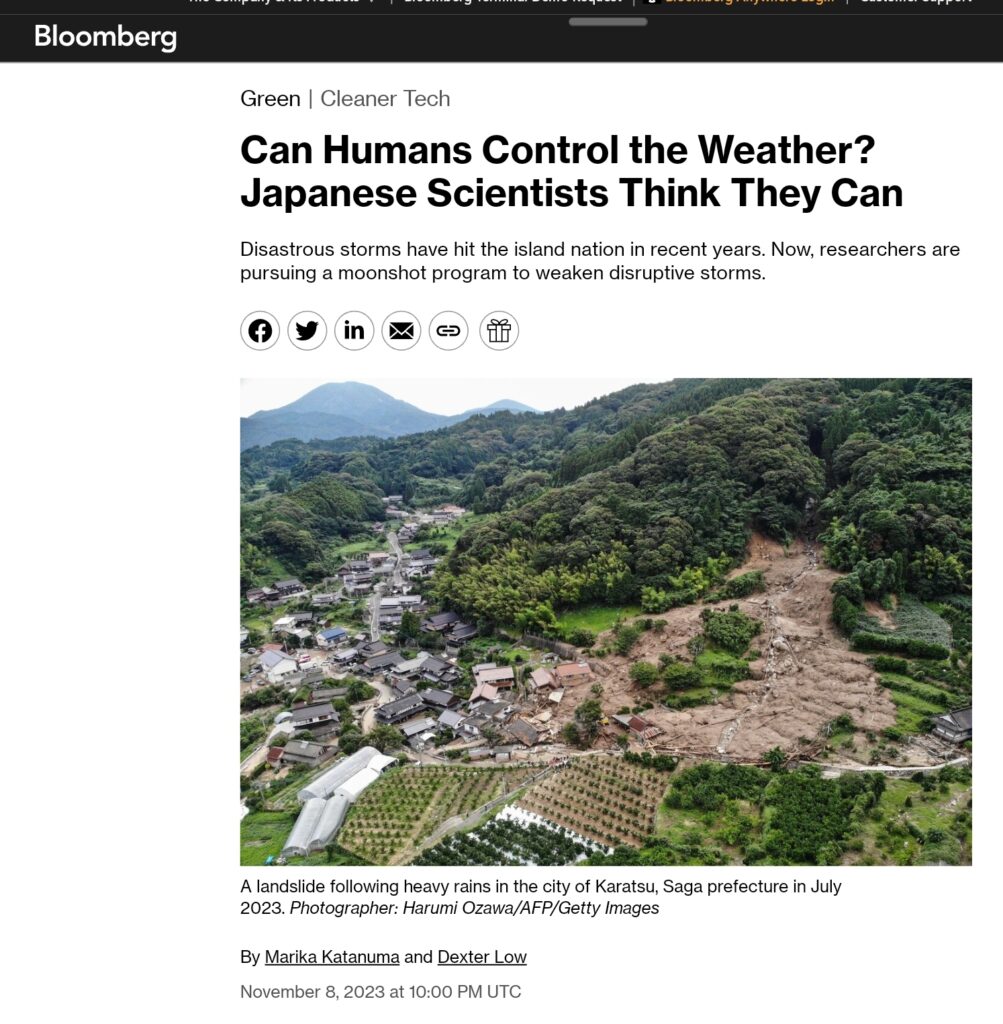From New York City to Hong Kong, extreme downpours have unleashed floods around the world this year with deadly results.
In an effort to control future rainstorms, scientists in Japan are working on an ambitious government-backed project involving everything from giant curtains floating on the sea to fields of wind turbines to protect the island nation. Their goal, they say, is to turn extreme weather into “a blessing” — if it works.
The effort feels ripped from the pages of a sci-fi novel, but it’s attracted dozens of researchers across Japan. The team, led by Kosei Yamaguchi, an associate professor at Kyoto University, is focused on reducing so-called “guerrilla” rainstorms that can bring large quantities of rainfall within a short period of time. Their goal is to develop an array of weather control technologies that can reduce deluges to manageable rain and roll them out by 2050.
‘Dams in the air’

Humans have attempted to modify the weather for decades. But with climate change making extreme weather more frequent and intense, interest is once again rising in weather modification.
…
Previous efforts have largely relied on a technique known as cloud seeding, which uses chemicals and tiny particles in the atmosphere to coax rain from clouds. The practice is in use today, including in China last year where authorities used it to try to break a drought. Efforts at cloud seeding and other forms of altering the weather have a “very checkered past,” according to Steven Siems, co-chair of an expert team on weather modification at the World Meteorological Organization (WMO).
…
The new Japanese plan would represent a step up in both the scale and types of interventions that could alter weather patterns. Siems, who is also a professor at the School of Earth Atmosphere and Environment at Australia’s Monash University, said the effort is “incredibly ambitious” but it will also be “very difficult” to take techniques that appear to work in computer models and apply them in the real world.
One method being considered is building what would essentially be a giant curtain that could be pulled by a kite attached to a boat, which could block humid air from rising off the sea. That would effectively disrupt a key step in the formation of cumulonimbus clouds that often produce heavy rain. The group is also contemplating using a group of wind turbines over 220 meters (720 feet) tall — or more than two-thirds the height of the Eiffel Tower — that could manipulate updrafts that also contribute to storm development.
“It’s like building dams in the air,” said Yamaguchi, explaining that the different technologies will act on different parts of cloud formation and back up each other, creating a multiplier effect.
Read more: What Japan’s Disaster-Proofing Strategies Can Teach the World
The team might also tap cloud seeding to change rainfall patterns as well. Yamaguchi recently modeled how manipulating cloud formation could’ve impacted a major rain storm in 2008 and found the technique could have lowered peak intensity by 27%.
“I’m skeptical,” said Hugh Willoughby, a research professor at Florida International University. “How about the wind stress on the curtain?”
…
Mixed history
While more than 50 countries have attempted to modify weather, success has proved more elusive. Major initiatives that include a US multimillion-dollar hurricane control program dubbed Project Stormfury that began in the 1960s and lasted over two decades, and a major cloud seeding experiment in Israel last decade have largely failed to achieve their desired results.
Weather researchers “have not done their homework on what’s been tried in the past and failed,” said Willoughby, who was the leading scientist of Project Stormfury. “They underestimate the energetic and physical scale of meteorological phenomena.”
The global climate is fundamentally chaotic and small perturbations can have major ripple effects. The sensitivity, coupled with limited data that can improve computer simulations, make weather prediction — let alone modification — challenging.
Even identifying the right places and when to intervene won’t be easy.
…
Weather modification for nefarious purposes have been used before. During the Vietnam War, the US military artificially seeded clouds with silver iodide to inhibit enemy troop movements and reduce the effectiveness of anti-aircraft attacks. It eventually moved away from the practice in 1972, while a United Nations convention passed four years later outlawed “military or any other hostile use of environmental modification techniques” against other states.
“I’m not hoping at all that the technology will be used for a bad cause,” said Yamaguchi, while acknowledging the risks. Researchers will evaluate the impacts of such interventions on floods and water resources in the next decade, he said, and attempt to mitigate associated risks. He added that the initial small-scale experiments are unlikely to affect neighboring countries.
“Historically Japanese people prayed for rain or for clear weather,” said Yamaguchi. “Now, we want to replace it with technology.”



